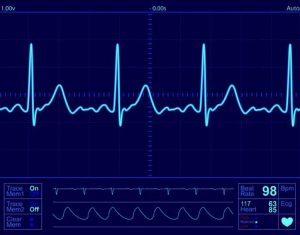
Electrocardiogram (EKG or ECG)
An Electrocardiogram, also known as EKG or ECG, is a noninvasive, painless bedside diagnostic test, which measures the electrical activity of the heartbeat. This procedure detects the heart’s electrical impulses then amplifies and records them producing a waveform with every beat of the heart. Examining these waveforms provides critical information about the condition of the heart and is used to determine the heart rate, heart rhythm and if parts of the heart are too large or overworked.
When is an EKG ordered?
- With symptoms such as chest pain, irregular or fast heart beats, shortness of breath
- When an abnormal heart exam is present such as a murmur or irregular rhythm
- When a family history or heritable heart disease is present
- To check the function of a pacemaker
- To monitor the use or toxicity of certain medicines
What to expect with your test
The technician attaches small adhesive sensors called electrodes to the your arms, legs, and chest. Lotions and thick hair can impair the readings so wipes may be used to clean the skin or a razor may be used to shave the hair where these electrodes will be placed. The electrodes are connected to the EKG machine by wires. Once all of your information has been entered in for the recording, the testing is started and you will be asked to hold still and not talk while the tracing is being made. This takes less than 15 seconds. Each tracing shows the electrical activity of the heart from different angles. These tracings are called the EKG. A standard EKG has 12 leads, which represent 12 different angles measuring the electrical current. An EKG can take anywhere from 2-5 minutes depending upon the prep time, such as shaving thick chest hair or removing lotions. The EKG is painless and there is no electricity sent into the body – it simply records the electrical activity of the heart.
What to expect after your test
- The electrodes will be removed and you will be allowed to sit up
- The EKG is immediately available for your doctor to review
How to prepare for the test
There is no preparation required but it is preferable that you avoid lotions on the chest, arms or legs.
